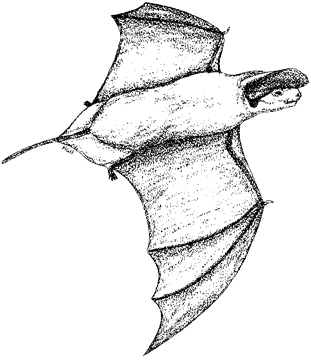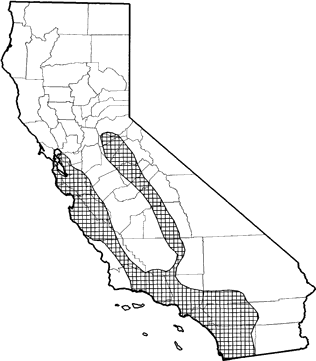
Western Mastiff Bat
Distribution, Abundance, and Seasonality
Uncommon resident in southeastern San Joaquin Valley and Coastal Ranges from Monterey Co. southward through southern California, from the coast eastward to the Colorado Desert. Occurs in many open, semi-arid to arid habitats, including conifer and deciduous woodlands, coastal scrub, annual and perennial grasslands, palm oases, chaparral, desert scrub, and urban.

Range Map
Specific Habitat Requirements
Feeding: Catches and feeds on insects in flight. In Arizona, Ross (1961) found that it fed primarily (58%) on night-flying hymenopterous insects. The insects consumed were relatively small, low-flying and weak-flying forms, and he concluded that the bats were feeding from ground to tree-level. However, over rugged terrain these bats typically forage at much greater heights (60 m,195 ft) above the ground (Krutzsch 1955, Vaughan 1959, Cockrum 1960).
Cover: Crevices in cliff faces, high buildings, trees, and tunnels are required for roosting (Howell 1920, Dalquest 1946, Barbour and Davis 1969). When roosting in rock crevices, needs vertical faces to drop off to take flight.
Reproduction: Nursery roosts described as tight rock crevices at least 90 cm (35 in) deep and 5 cm (2 in) wide, or crevices in buildings (Howell and Little 1924).
Water: No data found.
Pattern: Suitable habitat consists of extensive open areas with abundant roost locations provided by crevices in rock outcrops and buildings.
Species Life History
Activity Patterns: Yearlong nocturnal activity. Generally goes into daily torpor from December through February, but usually resumes activity each night to feed, except when temperatures drop below 5Á C (41 Á F), according to Leitner (1966). Nocturnal foraging range may exceed 24 km (15 mi) from roost sites (Vaughan 1959). This bat rarely uses night roosts as do other species (Cockrum 1960). Vaughan (1959) noted that this bat has an exceptionally long foraging period, up to 6-7 hr night.
Seasonal Movements / Migration: Non-migratory. Apparently moves among alternate daytime roosts (Howell 1920, Krutzsch 1955).
Home Range: No data found.
Territory: No data found. Roosts alone, or in smal colonies, usually of fewer than 100 bats (Barbour and Davis 1969).
Reproduction: Copulation probably occurs most frequently in early spring (March), when testes of adult males enlarge and descend (Cockrum 1960). Length of gestation period is unknown. In California, parturition may occur from early April through August or September (Krutzsch 1955, Barbour and Davis 1969). Parturitlon dates vary more for E. perotis than for any other bat in the U.S. (Barbour and Davis 1969). Apparently 1 young produced per female each yr. Except for tactile hairs on feet and face, young are born naked, probably with eyes closed (Barbour and Davis 1969). Adults of both sexes can be found together throughout the yr (Howe 1920, Krutzsch 1955). Both sexes of western mastiff bats possess a dermal gland on the throat that produces an odoriferous secretion. This gland, which is highly developed in males, especially during spring, probaby is related to reproductive processes (Barbour and Davis 1969).
Niche: The largest native bat in the U.S. The wings as in other members of the Family Molossidae, are distinctively long and narrow. Such morphology allows for rapid, sustained flight, but limits maneuverability (Vaughan 1966). This manner of flight is adaptive to flying in open habitats. Commonly shares roosts with other large bats, such as Eptesicus fuscus, Antrozous pallidus, and Tadarida brasiliensis (Barbour and Davis 1969).
Comments: A California Species of Special Concern (Williams 1986).
Sources & References
California Department of Fish and Game, 1999.
California's Wildlife, Sacramento, CA.
Written by: G. Ahlborn, reviewed by: M. White, edited by: M. White
Barbour, R. W., and W. H. Davis. 1969. Bats of America. Univ. of Kentucky Press, Lexington. 286pp. Cockrum, E. L. 1960. Distribution, habitat and habits of the mastiff bat, Eumops perotis, in North America. J. Arizona Acad. Sci. 1:79-84. Dalquest, W. W. 1946. The daytime retreat of a California mastiff bat. J. Mammal. 27:87-88. Grinnell, H. W. 1918. A synopsis of the bats of California. Univ. Calif. Publ Zool. 17:223-404. Howell, A. B. 1920. Contributions to the life history of the California mastiff bat. J. Mammal. 1:111-117. Howell, A. B., and L. Little. 1924. Additional notes on California bats, with observations upon the young of Eumops. J. Mammal. 5:261-263. Krutzsch, P. H. 1955. Observations on the Mexican free-tailed bat, Tadarida mexicana. J. Mammal. 36:236-242. Leitner, P. 1966. Body temperature, oxygen consumption, heart rate and shivering in the California mastiff bat, Eumops perotis. Comp. Biochem. Physiol. 19:431-443. Ross, A. 1961. Notes on food habits of bats. J. Mammal. 42:66-71. Vaughan, T. A. 1959. Functional morphology of three bats: Eumops, Myotis, Macrotus. Univ. Kans., Mus. Nat. Hist. Publ. 12:1-153. Vaughan, T. A. 1966. Morphology and flight characteristics of molossid bats. J. Mammal. 47:249-260. Williams, D. F. 1986. Mammalian species of special concern in California. Calif. Dept. Fish and Game, Sacramento. Admin. Rep. 86-1. 112pp.
California Animal Facts | California's Wildlife